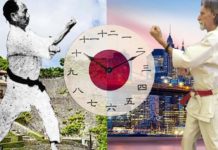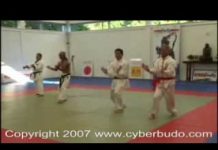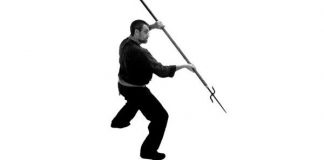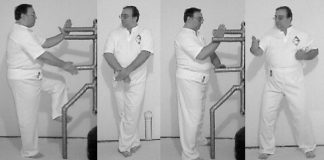So-called “Forms of Gentleness,” as the ju no kata is referred to, is a grossly misinterpreted standard of Kodokan. As performed in modern-day judo, it contributes little more than restricted and token help to judo training. I’ll begin by qualifying this statement.
The Japanese ideogram ‘ju’ coincides in form and meaning with its Chinese prototype, though not taken from Chinese conceptual sources. it was merely adopted as a Chinese ideogram for phonetic purposes. ‘Ju’ denotes various meanings in the Oriental mind which, in the English language, can be approximated only by concepts including: gentleness, softness, pliancy, yielding, tractibility, submissiveness, weakness, harmoniousness, as well as a state of being at ease. All of these denotations involve philosophical complexities of absoluteness and are not relative or practical connotations. Herein lies the source of the error.
The usual word selected for the international interpretation of the ideogram ‘ju’ is “gentleness.” This, however, is compounded and confused by the fact that the Japanese, including Jigoro Kano, endorsed it. But the word ‘gentleness’ had a different meaning to Jigoro Kano than it had for the westerner.
Not only has the interpretations of the ju no kata been undermined, but the very principle of judo has become warped and distorted from the original Kanoian thinking.
Westerners have accepted the Japanese selection of the word “gentleness” and have, arbitrarily, without familiarity or regard for the founder’s intentions, taken the word in its absolute denotation. By this absoluteness, “gentleness” has come to imply only soft, prissy, almost mamby-pamby sort of action or the “la-de-dah” type of movement which admits to no great application of muscle strength. Under this interpretation of “gentleness,” judo is all yield. To yield is esteemed, while hardness is shunned. Thus armed with this conceptual error, western Judo instructors are developing a “soft” Judo, thinking it to be in line with the founder’s ideas. Persistence in this type of thinking is doing great damage to western Judo (just as it did to jujitsu in Japan) and is certainly not in concept with the intention of the founder, Jigoro Kano, who always took exception to the abstract philosophical view and insisted on the narrower, but relative and practical outlook.
There is a large amount of documentation to support the Kanoian thought; but somehow it isn’t being seen, or if it is, it is not being correctly read or understood. In Jigoro Kano’s own writings we find:
… by giving way, a contestant may defeat his opponent; and as there are so many instances in Jujutsu (Judo) contests where this principle is applied, the name Jujutsu (Judo), the “gentle” or ” giving way” art, became the name of the whole art.
Such is the principle of ju. But, strictly speaking, real Jujutsu (Judo) is something more. The way of gaining victory over an opponent by Jujutsu (Judo) is not confined to gaining victory only by giving way.
Here it is evident that the founder did not consider “gentleness” to be “softness” or “yielding” as the entire makeup of the principle of Judo. He indicates that still another facet is inherent, by continuing:
Sometimes a person takes hold of his opponent’s wrist. How can someone possibly release himself without using strength against his opponent’s grip? The same thing can be asked when somebody is seized from behind around his shoulders by an assailant. If thus, the principle of giving way cannot cover all the methods used in Jujutsu (Judo) contests, is there any principle which really covers the whole field? Yes, there is; there is one principle which consistently emerges: In any form of attack, to attain our objective we must make the best use of our mental energy and physical strength. This is also true in defense.
It is now clear that the founder recognized the necessity of using strength to overcome some forms of resistance and included resistance itself within the principle of Judo. It is not the factor of strength that Dr. Kano opposed, but its misuse. Ju, in the principle of Judo, stresses flexibility in change or the adapting to any situation and economizing mental and physical energies
Perhaps a better interpretation of ju would have been “flexible” or “flexibility”; although these too, tend to narrow the tone. Yet, they seem to approach more closely the founder’s idea of ju.
The ju no kata is an exercise making use of the practical interpretation of “gentleness” — not its idealistic, absolute, and impractical meaning which most westerners attribute to it. As a kata, it is really not “gentle” at all. In the absolute sense. As a properly performed exercise, it is a smooth, efficient application of mental and physical strengths, a harmony of movement combining hardness and softness in economic balance, making the kata completely functional. In this kata there are moments of yielding and resisting in both roles of tori and uke; never is there a yielding action solely.
This fact provides an interesting test to its effect on Judoists who think it a useless exercise. If any well-conditioned Judoist will perform this kata correctly with a master performer, first as uke then as tori, he will find that no matter how well conditioned he may be, this kata will cause him to be covered with perspiration; his body muscles will “scream” in protest under the contractions and extensions imposed on them. To permit him to take each situation correctly, he would experience the actual moments of “softness” and “hardness” and the necessity for flexibility, both mental and physical. He would come away from this experience with a new and deep respect for ju no kata.
Figure 1. shows a correctly executed ukigoshi movement of the kata as its moment of climax. Compare its technical correctness of almost hyper-extended legs, lowered head, and flattened back with a pronounced lean to the right side, to the same movement being incorrectly performed in Figures 2 and 3.
Those Judoists unfamiliar with correct ju no kata technique might arbitrarily approve of the form in Figures 2 and 3. However, this form is filled with technical errors. Primarily, it is incorrect because the knees remain bent. They have not been fully extended. The upper body of tori is inclining instead of declining and has no lean to the right. Tori’s head is being dropped. This fact tends to round or hump the back, and make it impossible to “table” for uke’s use. Only a very skillful uke shown in these photos would have been able to salvage some exercise benefit for herself. Tori gets no real exercise benefit from the form shown, and perhaps comes away discouraged with the whole thing.
Today’s concept that ju not kata is not functional and that it is fit only for girls’ training as a dance or game is entirely wrong. Speaking with Professor Aida, the leading Kodokan authority on ju no kata, I found that the Professor had learned directly from Jigoro Kano. He proved to be a wealth of information.
While ju no kata may be ideally adapted to women’s training, it was not the founder’s idea to restrict this kata to the women’s dojo. In order to understand this better, let us take a brief but important look into the historical foundation of Judo.
In developing his Kodokan Judo system, Jigoro Kano was aware that a still older judo system existed, the Jikishin school. It represented a practical approach to combative exercises by being a synthesis of jujutsu systems. In one sense, it was a challenge to the Kodokan system. However, with jujutsu on the decline in the Meiji Period (1868 – 1912), anything similar in nature had little chance of survival. Professor Kano thus labored under terrific handicaps in bringing about a national interest and governmental recognition for his Kodokan system. By his tremendous foresight and his experience as an educator, he knew that unless his Judo system could obtain official governmental sanction, it too, was doomed along with jujutsu systems.
To achieve this sanction, he appealed to the Ministry of Education. Before he could do this, however, he had to show that Kodokan Judo differed from jujutsu as an educative entity in accord with the modern democratic society. One of the ways by which Professor Kano obtained approval for Kodokan Judo was through the ju no kata. It helped bring Judo into the educative sphere and meet the requirements and criteria characteristic of modern society’s educational needs.
When properly performed, ju no kata gives a balanced exercise for the whole body. Constant use of this kata over an extended time period results in a harmoniously developed, flexible, and strong body, as well as giving the user the fundamental mechanics for sport and self defense Judo applications.
Professor Kano’s original idea was for all Judoists, regardless of age or sex, to study and practice ju no kata. Ideally, it was to begin at an early age. Through constant practice, sound bodies could develop which might otherwise be less harmoniously developed by randori alone. Ju no kata was to be continued during adult training too, but with lesser need for body development. The higher skill of the adults with this kata permitted them to study applications of Judo mechanics and self-defense. A Judoist who might start late in life would be given ju no kata practice in order to bring his body condition to a more suitable level for randori.
The tendency to let girls “take over” ju no kata has, in the opinion of many Judo experts, seriously weakened its intrinsic values. This parallels one other such case in Japanese martial arts history. Originally, the naginata, a long halberd-type of bladed weapon, was a formidable weapon in combat. It remained in male samurai hands until the Tokugawa Period (1614 – 1867). As an effective weapon requiring perhaps the least amount of physical strength to make it combatively effective, the weapon was given to samurai women as their combative “baby.” Their consequent development of it has brought the naginata jutsu to today’s level of combative degeneration, and it has become largely an aesthetic practice. The nature of women making physical exercise beautiful, graceful, and the like, is similarly affecting the Kodokan ju no kata. even in Japan it has deservedly gained the appellation of odori no kata, or “dance forms,” and is the subject of ridicule by most young male Judoists who have never had sufficient experience to realize that this is not true ju no kata.
It is another case of the singer, not the song. The ju no kata of today can qualify only as a moderately good exercise, but it falls far short of the original Kanoian form. If efforts were to be made to recover the original form and if Judoists were to study and practice this kata as part of their normal training, all would benefit. Apparently, the limiting factor is the inability to find instructors who know and are able to teach the original form. Until this adjustment is made, Judoists will go on referring to it as “useless” and a waste of training time, and something which should be restricted to female trainees.
Judo instructors charged with placing and maintaining Kodokan Judo within educational institutions should realize that unless ju no kata is included as a regular part of Judo training, Judo is narrowed. It will not meet the criteria required of the Principle of Judo applied to self-defense situations; and unless the instructors are qualified through experience with this kata, he cannot hope to understand these elements. Nor can he teach this kata properly. The present day deficiencies in applying this kata to training can only be remedied by instructors who take the initiative to restore the Kano form.
By Donn Draeger






